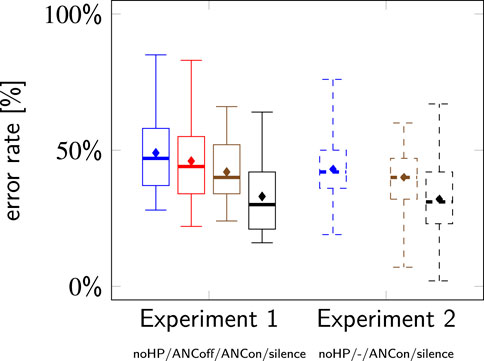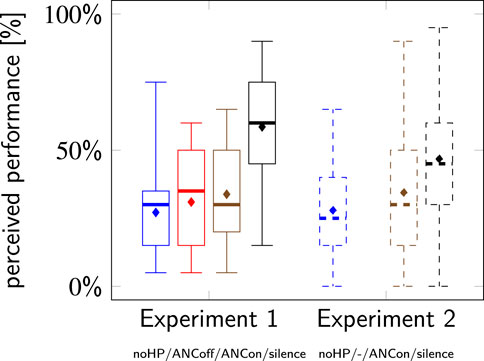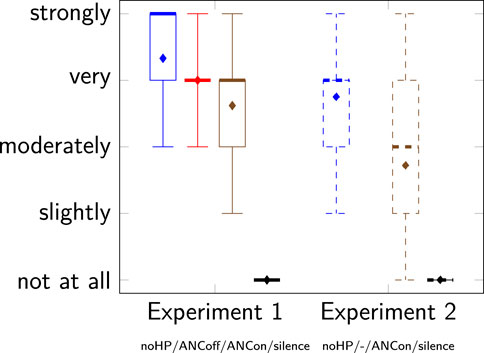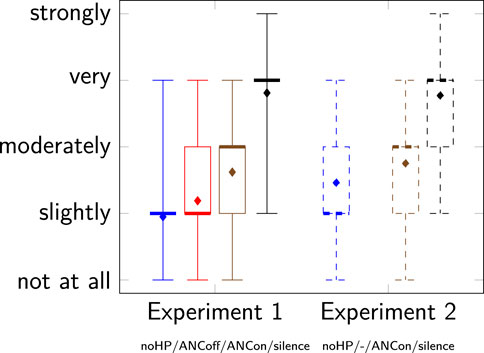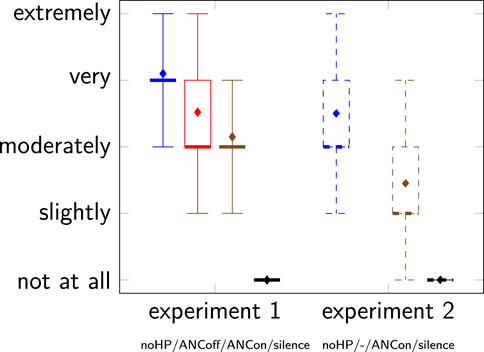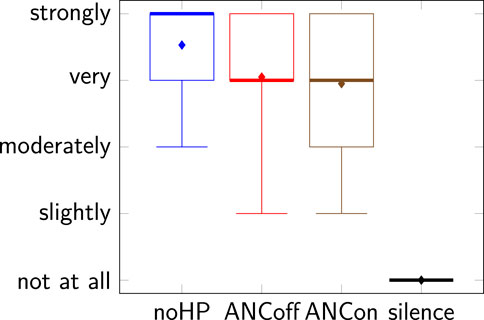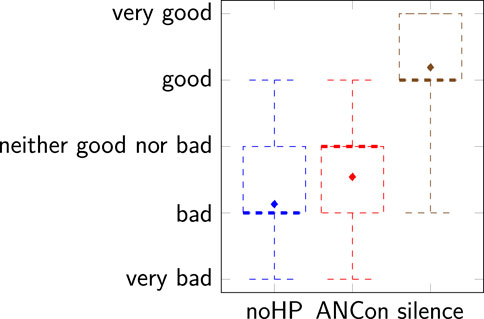- 1Department Acoustics, Fraunhofer-Institute for Building Physics, Stuttgart, Germany
- 2Department Psychology, Döpfer University of Applied Sciences, Regensburg, Germany
- 3Department Research Methods and Mathematical Psychology, University of Tübingen, Tübingen, Germany
High speech intelligibility in open-plan offices and thus a high changing-state character of the acoustic environment have been found to negatively influence cognitive performance. This is often attributed to the so-called irrelevant speech effect. Office workers lately use active noise-cancelling (ANC) headphones to improve the acoustic situation by blocking unwanted sound. However, it is currently unknown if using ANC headphones in a noisy setting improves cognitive performance. Two studies were conducted to examine if ANC headphones improve cognitive performance and the subjective well-being of employees in an open-plan office. Cognitive performance was measured using a serial recall test. Subjective assessments were measured using a questionnaire. The participants were tested in silence, speech without headphones, speech with ANC headphones switched off and speech with ANC headphones switched on. No statistically significant differences were found between the conditions with ANC headphones switched on and off as well as without headphones for cognitive performance. However, ANC headphones statistically significantly improved subjective assessments such as perceived privacy and the assessment of the acoustic environment. The results provide a scientific basis for evaluating and planning the appropriate use of ANC headphones for concentration-intensive activities such as office work.
1 Introduction
Several studies show, that acoustics in open-plan offices are the room parameter that leads to the most dissatisfaction compared to other building parameters such as climate and lighting conditions and also have statistically significant impacts on health (Frontczak et al., 2012; Leder et al., 2016; Di Blasio et al., 2019; Colenberg, Jylhä, and Arkesteijn 2021).
Nowadays, headphones with active noise cancellation (ANC) are increasingly used in the office as an individual coping mechanism, although the effects of ANC headphones in the office context have hardly been investigated so far. Most studies refer to the original use case of flight or work safety (B. R. Molesworth, Burgess, and Kwon 2013; Burgess and Molesworth, 2013; Ang et al., 2017).
One reason for the necessity of individual coping mechanisms is the disturbance caused by conversations and co-workers’ telephone calls in the office (Banbury and Berry 2005). It has been proven, that speech leads to a loss of cognitive performance of the working memory even at a level of 35 dB(A) (Schlittmeier, Hellbrück, et al., 2008). The decline in cognitive performance due to background speech has been called the irrelevant speech effect (ISE) (Colle and Welsh 1976). Although Colle (1980) has studied the effect only in regard to the short-term memory, various studies show negative influences of speech on memorizing numbers (Salamé and Baddeley 1982), reading aloud (R. C. Martin, Wogalter, and Forlano 1988), proofreading (Weinstein 1977; Jones, Miles, and Page 1990), and solving arithmetic problems (Banbury and Berry 1997; Banbury and Berry 1998). The ISE has been explained by different theories. Originally, it was founded with the working memory model of Baddeley (1986) and Baddeley (2003). According to this model, there is a spatial-visual notepad and a phonological loop. The irrelevant speech ties up the same resources in the phonological loop that are needed to process the concentration-intensive task (for example, remembering numbers). Therefore, a drop in working memory performance occurs. In contrast, another model (Oriented episodic record O-OER) addresses the changing-state behavior of irrelevant sounds rather than the linguistic character of the interfering sounds (Jones, Macken, and Murray 1993). According to this approach, objects (both the sound to be remembered and the irrelevant sound) that enter episodic memory are associated with markers that map the sequence of events. If the ambient noise is static, no markers need to be generated. If the ambient noise is not static and has a changing-state character, markers are created for both the events to be remembered and the irrelevant background sounds, which interfere with each other (Ellermeier and Zimmer 2014). Hughes (2014) duplex-mechanism account assumes that auditory distraction occurs in two functionally distinct forms. Interference-by-process occurs when the processing of the sound competes with a similar process that is consciously used to perform a main task. In contrast, auditory attentional capture occurs when a sound causes a distraction from the predominant task. The combination of these two factors leads to a distraction of cognitive performance due to a sound. In the unitary account, both the changing-state effect and the distraction effect are attributed to a diversion of attention. Attention is more drawn from a focal task when a sound is different from its immediate predecessor than when a sound is a repetition of the previous sound. The account suggests an attentional conceptualization of the ISE (Cowan 1995; Bell et al., 2012).
The ISE has been explicitly demonstrated for office background speech in several studies (Weinstein 1974; Loewen and Suedfeld 1992; Banbury and Berry 1997; Banbury and Berry 1998; Venetjoki et al., 2006). Hongisto (2005) has shown, the decline in performance due to background speech correlates strongly with the Speech Transmission Index (STI). The higher the STI between two adjacent workplaces in the office the more disruptive is the acoustic environment. To control the problems caused by speech and avoid the ISE, the STI (0 = not intelligible, 1 = perfectly intelligible) must be reduced at least below a value of 0.5 or even lower. Recent studies have shown that the decrease in cognitive performance begins above STI = 0.21 (Haapakangas, Hongisto, and Liebl 2020).
The manipulation of three different acoustical parameters, the so-called ABC measures, can reduce the STI: Absorption, blocking (shielding), and covering (sound masking). Above all, shielding and sound masking are decisive for reducing the STI, while the absorption in the office can be controlled quite easily by using an acoustic ceiling or other absorbing measures.
Sound masking methods raise the background noise through loudspeakers in the room (usually a −5 dB/octave filtered pink noise) and therefore cover speech signals. They have already been researched in detail and are able to increase cognitive performance in the office (Bradley 2003; Haapakangas, Kankkunen, et al., 2011; Liebl, Assfalg, and Schlittmeier 2016; Hongisto et al., 2016; Zaglauer, Drotleff, and Liebl 2017; J. Lee et al., 2021). Since sound masking adds noise, the overall level in the room is raised. Moreover, the masking noise cannot be influenced by the individual employee. Therefore, there are still reservations about the use of sound masking systems in the office context despite scientific evidence of the positive effect of sound masking on cognitive performance. This is supported by study results on the subjective perception of sound masking. Subjective well-being can even be reduced by the use of sound masking if the system cannot be controlled (Lenne, Chevret, and Marchand 2020). If the reverberation time has already reached an optimal value and sound masking cannot be used (for example, due to legal, country-specific requirements), merely only a third parameter remains to reduce the STI: shielding.
By using shielding walls between workstations, the disturbing speech sound is absorbed and blocked directly at the source (the speaker). This leads to a lower speech level at the other workstations and, in the optimum case, masking by the background noise. To adequately reduce the speech level of a person speaking in an office, the use of large, ceiling-high, efficiently absorbent shielding walls between workstations is necessary (Haapakangas, Hongisto, Hyönä, et al., 2014). However, an open-plan office aims to eliminate room-dividing elements. Therefore, only small screen walls attached to the desk are usually used for shielding. An open room structure without room-high separating elements and without sound masking leads to a high STI which only falls below the value of 0.5 at greater distances. This is also a problem in activity-based offices due to the open office structures (Lusa et al., 2019). Employees therefore need personal measures to escape the disturbing noise in the office. One possibility is the use of ANC headphones.
The effects of ANC headphones on the STI can in part be compared to shielding. The active and passive sound attenuation of the headphones reduce the overall level of office noise. However, classical shielding reduces the speech level of the person speaking in front of it but does not affect the diffuse background noise in the office. ANC headphones affect the acoustic environment differently. The background noise is reduced at least as well as the speech, if not better. This is because speech usually contains more and higher temporal spectral fluctuations than background noise (Lin et al., 2007).
This means that the signal-to-noise ratio between speech and background noise remains unchanged, while only the overall level decreases. There may even be a increase in the signal-to-noise ratio. Also, the active algorithms of the ANC headphones only influence low-frequency noise components up to about 1,000 Hz (i.e., in an office context, mainly low-frequency ventilation and background noise), whereas particularly speech-relevant components are attenuated exclusively by the passive sound insulation. A corresponding illustration of the sound attenuation caused by the ANC headphones used in this study and described later in detail is shown in Figure 1. The measurement was performed with a HEAD acoustics HMS III artificial head in a reverberation chamber with pink noise at 60 dB(A) according to ISO 4869-3:2007, 2007. Additionally, a measurement of the same ANC headphones is represented that was performed by playback of a speech signal (15 s, 1.5 m distance to artificial head and 0° angle, same recordings of the Oldenburger Satztest as in exp. 1.) with an artificial mouth in a free field room.
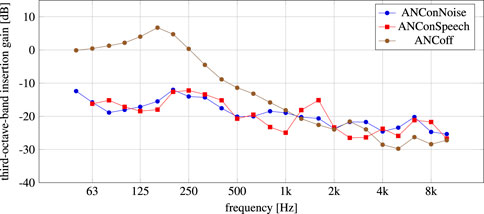
FIGURE 1. Third-octave-band insertion gain of ANC headphones used in this study with pink noise and speech as the test signal. Headphones turned off (ANCoff) and turned on (ANConNoise, ANConSpeech).
This overall level reduction may lead to an improvement in subjective perception, since, for example, a distracting talking person is perceived as farther away or quieter due to the lower level. But the question is whether it affects cognitive performance if the crucial parameter of the changing-state character of the ambient noise is hardly influenced by the headphones. Many studies have shown that especially a change in the signal-to-noise ratio of speech compared to background noise is crucial for the reduction of the STI and thus the ISE (N. D. Martin and Liebl 2017; Renz, Leistner, and Liebl 2019; Mueller et al., 2021). In addition, study results by Jahncke et al. (2016) have already shown that the use of headphones (without ANC) in the office has no significant influence on cognitive performance.
1.1 Aim of this study
The reasonable use of ANC headphones in office environments and their effect on cognitive performance can be questioned based on the technical properties and previous research results. However, no study is known to have systematically examined the effects. For this reason, the influence of ANC headphones on speech in the office, regarding both cognitive performance and subjective perception, was investigated in this study. Since no objective, but only subjective effects were found in the first experiment (Experiment 1) with 21 participants, a second experiment (Experiment 2) with a larger sample (n = 57) was conducted in order to be able to uncover smaller effects as well.
2 Method and experimental design
Two laboratory experiments investigated the effects of ANC headphones in open office spaces. In both experiments, cognitive performance was tested with a serial recall task under different sound conditions and the subjective assessment of the sound conditions was asked. Experiment 1 and Experiment 2 differed methodologically and are described below.
2.1 Experiment 1
2.1.1 Participants
In Experiment 1, data of 21 participants were collected. The participants were ranging in age from 21 to 69 years (M = 28.52 years, Mdn = 25 years, Sd = 12.1 years). 11 female and 10 male participants took part in the study. The participants had normal vision and hearing. All participants were first language speakers (German). They were paid for their participation.
2.1.2 Sound conditions
In Experiment 1, four different sound conditions were tested. The study was conducted in a listening test room with binaural recordings previously made in an open-plan office. The test conditions were: silence as a baseline condition, speech without headphones (noHP), speech with ANC headphones switched off (ANCoff) and speech with ANC headphones switched on (ANCon). Both switched off and switched on ANC headphones were chosen as a sound condition to be able to consider the influence of the passive as well as the active noise reduction individually in the listening test. The headphones were closed, circumaural ANC headphones for office use without certification as hearing protection.
For creating the binaural listening test sound conditions, an 8-person office was chosen. The ceiling was made of concrete and the floor was carpeted. There were no screens or walls between the workplaces. The reverberation time in the room was <0.9 s between 125–4,000 Hz. The background noise caused by technical systems and ventilation was around 35 dB(A) at all times. In the empty office, three speaker positions and one listener position (distance of speaker positions to the listener: 2.79, 5.97, 11.57 m) were chosen. The positions and orientations were based on the actual furniture and workplaces in the office and are shown in Figure 2 on the left.
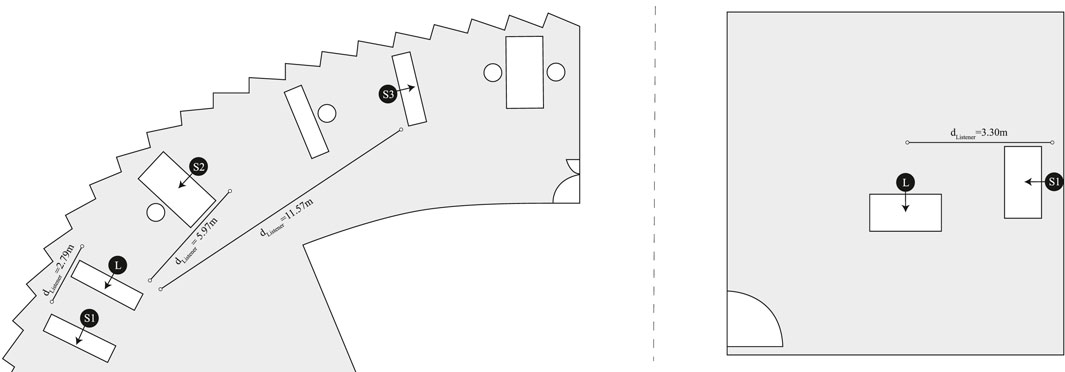
FIGURE 2. Floor plans of the rooms (gray area) used in Experiment 1 (left) and Experiment 2 (right) with listener (L) and speaker (S1, S2, S3) positions in black, office desks and head orientation. Ear height of both the speaker and listener positions: 1.20 m.
Studio speakers (Yamaha MSP3, similar directivity as a human speaker) were positioned at the three speaker positions. Anechoic recordings of the Oldenburger Satztest (Wagener, Brand, and Kollmeier 1999) by a male speaker were played back at all three positions by the studio speakers simultaneously to simulate simultaneous phone calls in the office. For each speaker position, different randomized sets of sentences were used with a speaker level of 59 dB(A) at 1 m distance according to ANSI/ASA S3.5-1997 (2017). The resulting sound condition consisted of three people in the office talking at the same time.
The sound conditions were recorded with a HEAD acoustics HMS III artificial head (equalization filter ID) at the listening position. For the ANCoff and ANCon conditions, the ANC headphones were placed on the artificial head. The fit of the headphones on the artificial head was checked for leaks. Condition noHP was recorded without ANC headphones. Figure 2 shows the experimental setup together with the conditions of Experiment 2.
Figure 3 shows the third-octave-band spectra of the sound conditions that were used in the listening test of Experiment 1 combined with the listening test conditions used in Experiment 2. The spectrum was calculated by energetically averaging the right and left channels of the binaural artificial head recording described earlier. In the spectrum, 3–5 dB higher levels below 400 Hz can be detected in the ANCoff condition than in the noHP condition. This can be explained by the use of randomized speech signals of the Oldenburger Satztest for the evaluation of the spectrum in the different experimental conditions. Furthermore, with ANC headphones turned off higher levels occur due to resonance effects below 250 Hz than without headphones. This is also shown in Figure 1.
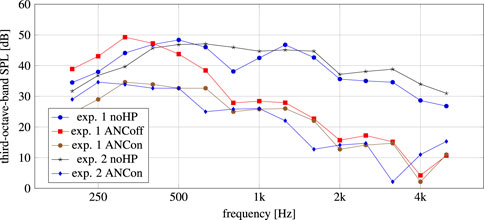
FIGURE 3. Third-octave-band spectra at listener position of the sound conditions used in Experiment 1 (exp. 1) with three simultaneously audible, independent speakers at different positions and Experiment 2 (exp. 2) with one audible speaker. Conditions without headphones (noHP), with ANC headphones switched off (ANCoff) and ANC headphones switched on (ANCon).
2.1.3 Design and procedure
The listening test was conducted in the High Performance Indoor Environment Laboratory at the Fraunhofer-Institute for Building Physics, which ensured controlled environmental conditions. The temperature was kept around 22°C with a volumetric flow rate of 600 m3/h and relative humidity around 50%, while the lighting conditions were kept steady. The experimental program was created using the PsyScope X Build 77 Experiment Control System software (Bonatti 2018). The previously recorded, binaural headphone signal recorded in the office with an artificial head was played to the participants by a HEAD acoustics PEQ V frontend and Sennheiser HD 600 headphones. Equalization of the binaural recordings and a calibrated headphone equalization as well as the calibrated playback level was ensured. The participants were tested individually and seated at a desk in the laboratory in front of a computer screen to process the serial recall and answer the questions. A repeated measures design with four levels of the independent variable tested in a within-subjects design (baseline condition: silence, headphones–with ANC: ANCon, headphones–without ANC: ANCoff, no headphones: noHP) was used. The sound conditions were presented in a randomized order.
Regarding cognitive performance, the dependent variable was the error rate (percentage of incorrectly entered numbers) in a serial recall task. A fixation cross was therefore first presented to the participants for 1.5 s. Subsequently, nine different numbers from 1-9 were displayed on the screen in randomized order, each for 0.7 s with a pause of 0.3 s between numbers. This was followed by a retention interval of 8 s during which nothing was displayed. After that, the numbers had to be entered in the correct order by pressing buttons in a 3 × 3 array on the screen. The numbers were displayed from top left to bottom right in ascending order. After a number was selected, it was hidden so that it could not be selected again. The test was not timed. An inter-trial interval of one second followed the complete answer. Each digit that was not recalled at the correct serial position was counted as an error. After six practice trials, the participants completed 12 trials per background sound condition. During the serial recall test, the sound condition was continuously audible. Additionally, the participants were asked at the end of each of the four sound condition to evaluate their subjective assessment. The query of subjective judgments was performed by the experimental program. A five-point Likert scale (not at all, slightly, moderately, very, extremely) was used for all questions according to ISO/TS 15666:2003, 2003. For the loudness ranking, the scale according to DIN ISO 16832:2007-07, 2007 (not at all, slightly, moderately, very, strongly) was used:
1) How much has the overall background sound condition bothered, disturbed, or annoyed you during the last few minutes?
2) When you think about the last few minutes, how was your ability to concentrate?
3) When you think about the last few minutes, how loud do you think the speaker was?
4) Please assess your subjectively perceived performance in the serial recall test in the last few minutes on a scale from 0% (no correct answers) to 100% (only correct answers).
5) When you think about the last few minutes, how would you rate the long-term disturbance of the sound condition?
6) Please describe the perceived distance to the speaker in meters.
2.2 Experiment 2
2.2.1 Participants
In Experiment 2, data of 57 participants were collected to detect possible smaller effects. The participants were different from those in Experiment 1. The participants were ranging in age from 19 to 56 years (M = 27.53 years, Mdn = 28 years, Sd = 7.79 years). 31 female and 26 male participants took part in the study. The participants had normal vision and hearing. All participants were first language speakers (German). They were paid for their participation.
2.2.2 Sound conditions
The apparatus and stimuli of Experiment 2 varied from the conditions used in Experiment 1. In total 14 sound conditions were tested in Experiment 2, including conditions with masking sounds, although only three of them are relevant to the current analysis: One condition without a speaker (silence), one condition with a speaker (noHP), and one condition with a speaker and ANC headphones turned on (ANCon). Again, anechoic recordings of the Oldenburger Satztest (Wagener, Brand, and Kollmeier 1999) were used for creating the sound conditions, but this time the voice of a female speaker instead of a male voice was used. In comparison to Experiment 1 no prerecorded binaural recordings of an office and only one speaker instead of three simultaneous speakers were used in this experiment. The recordings were played back by a studio loudspeaker (Genelec 8,350, with similar directivity as a human speaker) in the listening test room at a distance of 3.3 m to the subject, with an angle of −90° to viewing direction and a level of 59 dB(A) at 1 m distance resulting in 56 dB(A) at listening position. The background sound condition thus represented a continuously talking colleague sitting on his table on the left. The reverberation time in the room was <0.6 s between 125–4,000 Hz. The background noise was around 35 dB(A) at all times. In Experiment 2, participants in the ANCon condition had the headphones on to create a more practical listening test situation. In conditions silence and noHP, the participants did not wear headphones. In contrast to Experiment 1 no condition with ANC headphones turned off was tested due to time constraints. The headphones were the same as in Experiment 1. Figure 2 shows the experimental setup together with the conditions of Experiment 1 where binaural recordings were used. Figure 3 shows the third-octave-band spectra of the sound conditions that were used in the listening test of Experiment 2 combined with the listening test conditions used in Experiment 1.
2.2.3 Design and procedure
As in Experiment 1, the listening test was conducted in the High Performance Indoor Environment Laboratory of the Fraunhofer-Institute for Building Physics with the same controlled environmental conditions. The experimental program was created using the PsyScope X Build 77 Experiment Control System software (Bonatti 2018). The speech signal was played by a studio loudspeaker in the listening test room as described in Section 2.2.2. The participants were tested individually and seated at the listener position as shown in Figure 2 at a desk in front of a computer screen to process the serial recall and answer the questions. A one-way repeated measures design with three levels of the independent variable tested in a within-subjects design (baseline condition: silence, headphones: ANC, no headphones: noHP) was used. The sound conditions were presented in a randomized order. The dependent variable regarding cognitive performance was the error rate (percentage of incorrectly entered numbers) in a serial recall task that was carried out as in Experiment 1. The additional questions at the end of each condition were assessed by the same scales as in Experiment 1. In Experiment 2, the questions about the mean perceived distance to the speaker during the different sound conditions as well as the mean long-term disturbance during the different sound conditions were not asked due to time constraints. Instead, the participants had to assess the overall surrounding sound environment according to ISO/TS 12913-3, 2019. The questions used in Experiment 2 were:
1) How much has the overall background sound condition bothered, disturbed or annoyed you during the last few minutes?
2) When you think about the last few minutes, how was your ability to concentrate?
3) When you think about the last few minutes, how loud do you think the speaker was?
4) Please assess your subjectively perceived performance in the serial recall test in the last few minutes on a scale from 0% (no correct answers) to 100% (only correct answers).
5) Overall, how would you describe the surrounding sound environment in the last few minutes?
2.3 Statistical analysis
The processing of the raw data for the serial recall task and the subjective judgments was done in Microsoft Excel 2016. An outlier correction was conducted. Data that deviated by more than 2.5 times the standard deviation from the mean was excluded from the evaluation. This affected 2 out of 84 data points of the objective evaluation and 3 of 483 data points of the subjective evaluation in Experiment 1 as well as 4 out of 171 data points of the objective evaluation and 18 of 1,026 data points from the subjective evaluation in Experiment 2. All further statistical analyses were performed using R (version 3.5.2) in RStudio (RStudio Team 2021). The data were checked for normality. The significance level was set to α = 0.05. A repeated measures ANOVA was performed to compare the effect of the sound conditions on subjective and objective variables. When selecting the evaluation method, potential limitations due to the 5-point Likert scale for some question items were considered. In light of the literature review of Norman (2010) on the validity of parametric statistical tests for ordinal data, the evaluation was performed by ANOVA. The Greenhouse-Geisser adjustment was used to correct for violations of sphericity if needed. Bonferroni-adjusted post-hoc analyses were performed if the ANOVA revealed significant effects. Cohen’s d was used as a measure of effect size for this analysis.
3 Results
Relevant results are described below. In addition, all results of the t-tests can be found in Table 1. In all of the following descriptive diagrams, boxplots are plotted. In the diagrams the plots on the left side show the results of Experiment 1 and the dashed plots on the right side show the results of Experiment 2.
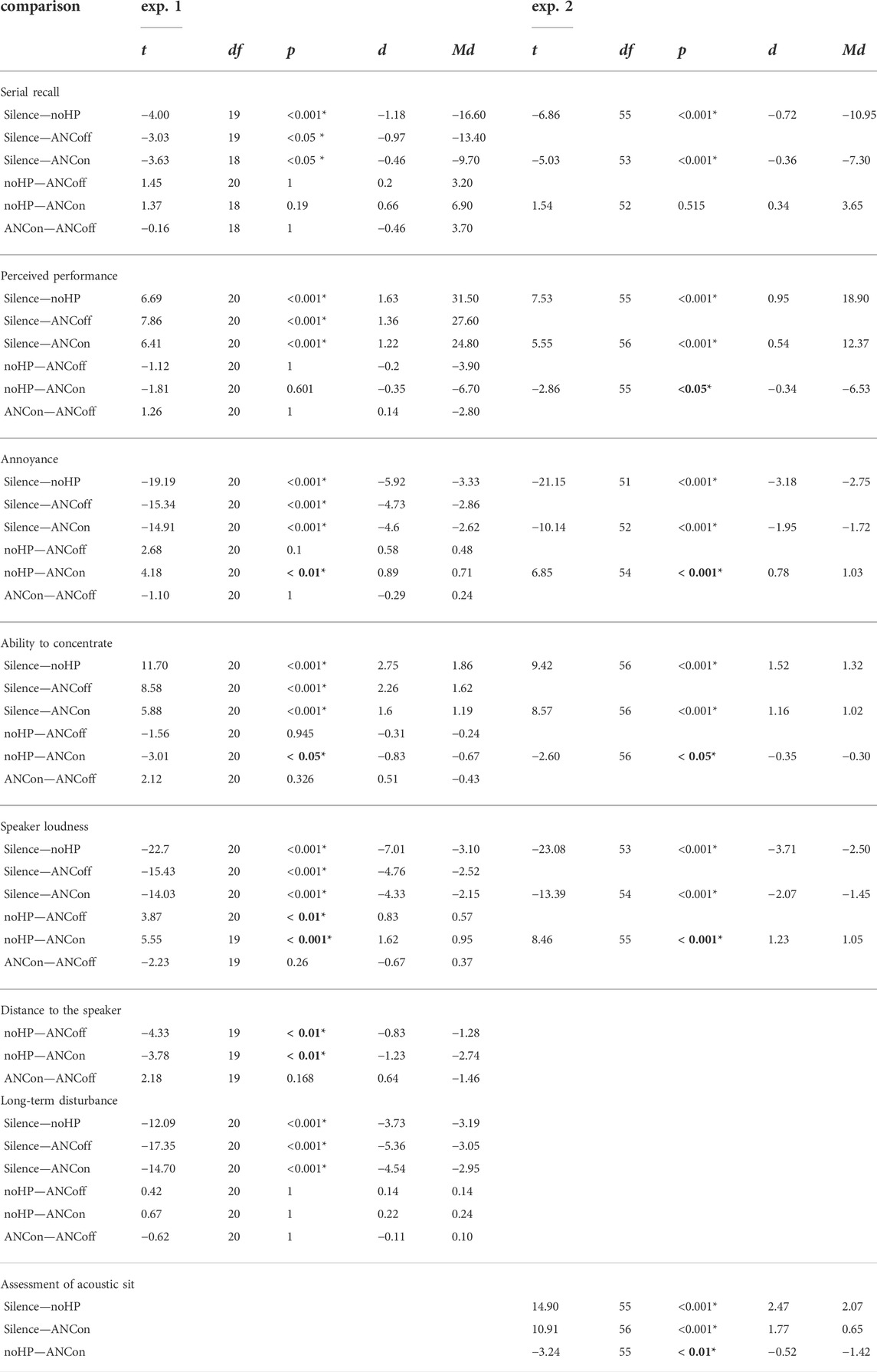
TABLE 1. Overview of t-tests of mean error rates in the serial recall as well as of the subjective assessments during the different sound conditions with adjusted p-values (Bonferroni-correction) and Cohen’s d effect size as well as the mean differences (Md) and degrees of freedom (df). Statistically significant findings except for tests against silence are indicated in bold.
3.1 Serial recall
3.1.1 Experiment 1
The error rates (incorrectly recalled numbers) in the different sound conditions were measured. A repeated measures ANOVA showed a statistically significant effect of the background sound factor on error rate (F (3, 60) = 8.64, p
3.1.2 Experiment 2
A repeated measures ANOVA showed a statistically significant effect of the background sound factor on error rate (F (2, 112) = 10.68, p
In silence, the error rate in both experiments was statistically significantly lower than in the other sound conditions (see Table 1), which indicates a correct experimental setup, since the ISE was caused. The descriptive presentation of the results of Experiment 1 and Experiment 2 is shown in Figure 4. In both experiments, no statistically significant effects of the ANC headphones on cognitive performance could be proven.
3.2 Subjective assessment
3.2.1 Subjectively perceived performance
3.2.1.1 Experiment 1
The comparison of subjectively perceived performance in the serial recall test in the various background sound conditions by a repeated measures ANOVA showed a statistically significant effect of the factor background sound on the dependent variable subjectively perceived performance (F (3, 60) = 30.520, p
3.2.1.2 Experiment 2
The comparison of subjectively perceived performance in the serial recall test in the various background sound conditions by a repeated measures ANOVA showed a statistically significant effect of the factor background sound on the dependent variable subjectively perceived performance (F (2, 112) = 32.51, p
Only Experiment 2 showed statistically significantly higher subjectively perceived performance when ANC headphones were used with a small effect size of d = 0.34. In silence, the subjectively perceived performance was statistically significantly higher than in any other sound condition in both experiments (see Table 1). The descriptive presentation of the results of Experiment 1 and Experiment 2 is shown in Figure 5.
3.2.2 Annoyance
3.2.2.1 Experiment 1
The comparison of annoyance in the various background sound conditions by a repeated measures ANOVA showed a statistically significant effect of the factor background noise on the dependent variable annoyance (F (3, 60) = 132.24, p
3.2.2.2 Experiment 2
The comparison of annoyance in the various background sound conditions by a repeated measures ANOVA showed a statistically significant effect of the factor background sound on the dependent variable annoyance (F (2, 112) = 153.3, p
Both experiments showed statistically significantly lower annoyance assessments when ANC headphones were turned on. Silence was perceived as statistically significant less annoying than any other sound condition in both experiments (see Table 1). The descriptive presentation of the results of Experiment 1 and Experiment 2 is shown in Figure 6.
3.2.3 Ability to concentrate
3.2.3.1 Experiment 1
The comparison of the subjectively perceived concentration in the different background sound conditions by a repeated measures ANOVA showed a statistically significant effect of the factor background sound on the dependent variable concentration (F (3, 60) = 37.977, p
3.2.3.2 Experiment 2
The comparison of the subjectively perceived concentration in the different background sound conditions by a repeated measures ANOVA showed a statistically significant effect of the factor background sound on the dependent variable concentration (F (2, 112) = 61.08, p
Both experiments showed statistically significantly higher assessments of the perceived ability to concentrate when ANC headphones were used and turned on. In silence, the perceived ability to concentrate was statistically significantly higher than in any other sound condition in both experiments (see Table 1). The descriptive presentation of the results of Experiment 1 and Experiment 2 is shown in Figure 7.
3.2.4 Speaker loudness
3.2.4.1 Experiment 1
The comparison of perceived speaker loudness in the different background sound conditions by a repeated measures ANOVA showed a statistically significant effect of the factor background sound on the dependent variable loudness (F (3, 57) = 163.369, p
3.2.4.2 Experiment 2
The comparison of perceived speaker loudness in the different background sound conditions by a repeated measures ANOVA showed a statistically significant effect of the factor background sound on the dependent variable loudness (F (2, 112) = 182.2, p
Both experiments showed statistically significantly lower perceived speaker loudness assessments when ANC headphones were used. All results can also be found in Table 1. The descriptive presentation of the results of Experiment 1 and Experiment 2 is shown in Figure 8.
3.2.5 Distance to the speaker
3.2.5.1 Experiment 1
The comparison of the perceived distance to the speaker (see Figure 9) in the different background sound conditions by a repeated measures ANOVA showed a statistically significant effect of the factor background sound on the dependent variable distance (F (2, 38) = 11.047, p
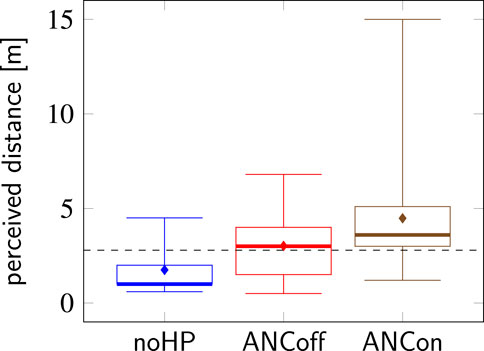
FIGURE 9. Boxplots, showing the perceived distance to the speaker with actual nearest speaker position (dashed line). Only exp. 1.
3.2.6 Long-term disturbance
3.2.6.1 Experiment 1
The comparison of the long-term disturbance (see Figure 10) in the various background sound conditions by a repeated measures ANOVA showed a statistically significant effect of the factor background sound on the dependent variable long-term disturbance (F (1.62, 30.76) = 65.573, p
3.2.7 Assessment of the acoustic situation
3.2.7.1 Experiment 2
Comparing the assessment of the acoustic situation (see Figure 11) in the various background sound conditions by a repeated measures ANOVA showed a statistically significant effect of the factor background sound on the dependent variable acoustic assessment (F (2, 112) = 123.3, p
4 Discussion
The presented study aimed to examine how ANC headphones influence cognitive performance and subjective well-being while being affected by irrelevant speech in an office environment. Based on the results of prior studies reported in Section 1, cognitive performance was not expected to be affected. As ANC headphones do not change the signal-to-noise ratio between speech and background noise, speech with headphones remains similarly intelligible to speech without headphones which leads to equal impairment (Ellermeier and Hellbruck, 1998).
In both experiments of this study, the error rate for the serial recall in the control condition silence was statistically significantly lower than in all other conditions. This indicates the occurrence of the ISE by the speaker. As expected, the error rate in the headphone conditions was neither statistically significantly lower in the condition ANCoff nor in ANCon than in condition noHP. Also, there was no statistically significant difference between ANCon and ANCoff in Experiment 1 regarding the error rates in the serial recall test. From this result, it can be concluded that ANC headphones do not seem to have any influence on cognitive performance. One possible reason could be the relation between speech level, speech intelligibility, and the ISE. As long as speech is loud enough, the speech level is not relevant for the ISE, only the changing-state character of the speech signal is (Macken et al., 2001). The channging-state character can even increase with ANC headphones, as background noise up to 1,000 Hz is very well reduced, but speech is less well cancelled by the active algorithm due to its transients and the slight delay of the noise cancelling signal (Elliott and Nelson 1990; Niu, Qiu, and Zhang 2020). This study therefore extends the findings of Jahncke et al. (2016), who examined the effectiveness of headphones without ANC and also found, that merely wearing headphones (without masking) alone did not affect the performance (serial short-term memory) while background speech is heard.
Although no statistically significant improvement in cognitive performance was found, ANC headphones seem to improve the perception of the acoustic condition in open-plan offices. The participants rated the annoyance of the speech sound in condition ANCon as statistically significantly less annoying than in noHP with a large effect size in both experiments. The condition without headphones was rated between very and strongly annoying in Experiment 1 and very annoying in Experiment 2. In comparison, participants perceived the condition with ANC headphones ANCon only between moderately and very annoying in Experiment 1 and less than moderately annoying in Experiment 2. In Experiment 1, no statistically significant difference was found between the noHP and ANCoff conditions, suggesting that the additional low-frequency level reduction provided by the ANC algorithm helps to reduce the perceived annoyance as differences could be found while comparing the noHP and ANCon conditions. Also, the subjective ability to concentrate in the condition ANCon was rated as statistically significantly higher than in noHP with a large effect size. This result could be replicated in Experiment 2. In both experiments, subjective ability to concentrate was enhanced by ANC headphones turned on from slightly to moderately. As regarding annoyance, no statistically significant difference in subjective ability to concentrate could be found when comparing noHP to ANCoff which also indicates that the ANC algorithm leads to a subjective improvement. In terms of perceived privacy, ANC headphones may be useful as well. In both experiments, the participants rated the speaker loudness with headphones as lower and perceived distance to the speaker as higher, which is mainly due to the insertion loss of the headphones. The results of these two subjective assessments differed from the previously reported assessments of annoyance and ability to concentrate. A statistically significant difference was found between the condition without headphones and the condition ANCoff as well as between the condition without headphones and ANCon. One possible reason could be that ANC headphones already have a passive sound attenuation of 20–30 dB above 1,000 Hz even when switched off so that the speech-relevant frequency components are sufficiently reduced for the level reduction to be subjectively perceptible. Concerning the perceived privacy, the headphones per se—without the ANC algorithm switched on—therefore seem to have a positive effect. However, both in terms of speaker loudness and in terms of the perceived distance to the speaker, higher effect sizes and better subjective ratings were found with the ANC algorithm switched on than with ANC switched off compared to the condition without headphones. The ANC headphones managed to raise the perceived distance from 1.80 m for the condition without headphones to 4.50 m for the condition ANCon. Speaker loudness was reduced from very to moderately in Experiment 1 and from between very and moderately to between slightly and moderately in Experiment 2. The results of the survey on long-term disturbance and subjective performance coincide with the results of the serial recall test, where no statistically significant differences could be found when comparing noHP and ANCon as well as noHP and ANCoff. With respect to the long-term disturbance, in Experiment 1, no statistically significant differences could be found between either of the headphone conditions and noHP. The lack of reduction in long-term disturbance from ANC headphones could be caused by the fact that wearing ANC headphones can also be uncomfortable in the long run due to the occlusion of the ear canal. Regarding subjective performance during the serial recall task, Experiment 1 also showed no statistically significant differences between the condition without headphones and the conditions with headphones. In contrast, Experiment 2, in which more participants were tested, revealed a statistically significant difference between noHP and ANCon on subjective performance, although the effect was small. Furthermore, in Experiment 2 the acoustic situation was assessed statistically significantly better in condition ANCon than in condition noHP with a medium effect size. While the acoustic situation without headphones was rated as bad, the assessment of the acoustic situation with ANC headphones increased to an assessment between neither good nor bad and good.
Regarding both the objective and subjective experiments, no statistically significant worsening by ANC headphones was found in any area. The ANC headphones rather significantly improved every subjective judgment item except for long-term disturbance and subjective performance during the serial recall test as well as the objective results of the serial recall task. Although no enhancement in cognitive performance was demonstrated with ANC headphones, the improvements in subjective perception found in this study might be sufficient on their own to justify the use of ANC headphones in open-plan offices.
The observed discrepancy between cognitive and subjective data in this study is also not an outlier in the field of noise disturbance (Haapakangas, Kankkunen, et al., 2011; Schlittmeier, Weissgerber, et al., 2012). ANC headphones offer individual coping mechanisms for office noise. Even if they are not widely used or recommended by a company for its employees, they are available as a personal purchase. Kaarlela-Tuomaala et al. (2009) already showed that a commonly used technique to cope with noise in open-plan offices was listening to music, although music is not an effective masking noise (Haapakangas, Kankkunen, et al., 2011; N. D. Martin and Liebl 2017). The actual effectiveness seems to be less important to employees than the perceived comfort. In this sense, individual control of ANC headphones is an advantage in itself. Office noise is a source of stress which is very variant and uncontrollable. Cohen (1980) found with respect to high stress situations, that the effect of stress on performance is smaller, when participants had a feeling of control over the situation, even if that control was only perceived. ANC headphones, therefore, have the potential to increase the acceptance of open-plan offices because they offer individual coping mechanisms to the employees. The improvement in subjective judgments could also have an indirect effect on the productivity of those working in the office, although no differences in cognitive performance were found. In addition to concentration problems caused by speech or bad acoustics, noise in the office leads to interruptions in work, which can also result in a considerable loss of time. Furthermore, employees in open-plan offices are more likely to report fatigue or headaches, complain more frequently, and are more likely to be ill (Pejtersen et al., 2006; Bodin Danielsson and Bodin 2009; Bodin Danielsson, Chungkham, et al., 2014). By improving subjective judgments through ANC headphones, these time losses could be reduced, leading to indirect increased productivity.
Due to the small sample size in both experiments, the results presented here must be interpreted with caution. Future studies with larger samples are needed to evaluate if the pattern established here can be replicated. Furthermore, the investigations in this study as well as most of the other studies on the ISE were conducted under laboratory conditions. The serial recall task used to test cognitive performance does not represent every activity performed in an office, but only allows conclusions to be drawn about the impairment of the working memory by speech. The effects of ANC headphones on less concentration-intensive or even creative tasks were not examined in this study. However, the improved subjective assessments with ANC headphones suggest that they may also provide subjective value for other activities. Investigation of these effects and validation through field studies should be conducted in subsequent studies. Also, a combination of ANC headphones and masking sounds, played back by the headphones, could be tested, as the headphones lower the overall sound level and therefore a quieter masking signal may be required to reduce disturbing speech and improve the working conditions of employees in open-plan offices.
5 Conclusion
In both experiments, no statistically significant effects of ANC headphones on cognitive performance were demonstrated. In this regard, ANC headphones do not seem to have beneficial impacts on cognitive performance while working in an open-plan office. Although no enhancement in cognitive performance was revealed with ANC headphones, the improvements in subjective perception found in this study might be sufficient on their own to justify the use of ANC headphones in open-plan offices. They statistically significantly reduced the annoyance of conversations between other employees, raised the subjective ability to concentrate, and increased perceived privacy as well as the perceived distance to the speaker with medium to big effect sizes, which are all factors critical for undisturbed and productive office work.
When using ANC headphones in the office, there should be an awareness that no positive effects on one’s own cognitive performance can be expected. Proven effective measures such as activity-based work, high shielding, or masking to reduce the disturbing effect of speech should be used in any case and not be replaced by ANC headphones, especially when it comes to room acoustic and organizational measures. As a complementary measure to further improve the acoustic situation subjectively, they can be used based on the study results, as they do not seem to worsen cognitive performance and improve various subjective judgments.
Data availability statement
The raw data supporting the conclusion of this article will be made available by the authors, without undue reservation.
Ethics statement
Ethical review and approval was not required for the study on human participants in accordance with the local legislation and institutional requirements. The patients/participants provided their written informed consent to participate in this study.
Author contributions
BM, AL, NH, DK, and PL contributed to conception and design of the study. BM, DK, and NH performed the statistical analysis. BM and DK wrote the first draft of the manuscript. BM, AL, NH, DK, and PL wrote sections of the manuscript. All authors contributed to manuscript revision, read, and approved the paper.
Conflict of interest
The authors declare that the research was conducted in the absence of any commercial or financial relationships that could be construed as a potential conflict of interest.
Publisher’s note
All claims expressed in this article are solely those of the authors and do not necessarily represent those of their affiliated organizations, or those of the publisher, the editors and the reviewers. Any product that may be evaluated in this article, or claim that may be made by its manufacturer, is not guaranteed or endorsed by the publisher.
References
Ang, L. Y. L., Koh, Y. K., and Lee, H. P. (2017). The performance of active noise-canceling headphones in different noise environments. Appl. Acoust. 122, 16–22. doi:10.1016/j.apacoust.2017.02.005
ANSI/ASA S3.5-1997 (R2017) (2017). Methods for calculation of the speech intelligibility Index. American National Standards Institute.
Baddeley, A. (1986). Working memory. New York, NY, US: Clarendon Press/Oxford University Press, xi, 289.
Baddeley, A. (2003). Working memory: Looking back and looking forward. Nat. Rev. Neurosci. 4, 829–839. doi:10.1038/nrn1201
Banbury, S., and Berry, D. C. (1998). Disruption of office-related tasks by speech and office noise. Br. J. Psychol. 89, 499–517. doi:10.1111/j.2044-8295.1998.tb02699.x
Banbury, S., and Berry, D. C. (1997). Habituation and dishabituation to speech and office noise. J. Exp. Psychol. Appl. 3, 181–195. doi:10.1037/1076-898X.3.3.181
Banbury, S., and Berry, D. C. (2005). Office noise and employee concentration: Identifying causes of disruption and potential improvements. Ergonomics 48, 25–37. doi:10.1080/00140130412331311390
Bell, R., Röer, J., Dentale, S., and Buchner, A. (2012). Habituation of the irrelevant sound effect: Evidence for an attentional theory of short-term memory disruption. J. Exp. Psychol. Learn. Mem. cognition 38, 1542–1557. doi:10.1037/a0028459
Bodin Danielsson, C., and Bodin, L. (2009). Difference in satisfaction with office environment among employees in different office types. J. Archit. Plan. Res. 26 (3), 241–257.
Bodin Danielsson, C., Chungkham, H., Wulff, C., and Westerlund, H. (2014). Office design’s impact on sick leave rates. Ergonomics 57, 139–147. doi:10.1080/00140139.2013.871064
Bonatti, L. (2018). Welcome to the PsyScope X info page. Available at: http://psy.ck.sissa.it/.
Bradley, J. (2003). The acoustical design of conventional open plan offices. Can. Acoust. - Acoust. Can. 31 (2), 23–31.
Burgess, M., and Molesworth, B. (2013). Investigation of the role for noise cancelling headphones to assist speech recall in noise. Proc. Meet. Acoust. ICA2013 19, 1. doi:10.1121/1.4805321
Cohen, S. (1980). Aftereffects of stress on human performance and social behavior: A review of research and theory. Psychol. Bull. 88, 82–108. doi:10.1037/0033-2909.88.1.82
Colenberg, S., Jylha, T., and Arkesteijn, M. (2021). The relationship between interior office space and employee health and well-being–a literature review. Build. Res. Inf. 49, 352–366. doi:10.1080/09613218.2019.1710098
Colle, H. (1980). Auditory encoding in visual short-term recall: Effects of noise intensity and spatial location. J. Verbal Learn. Verbal Behav. 19 (6), 722–735. doi:10.1016/S0022-5371(80)90403-X
Colle, H., and Welsh, A. (1976). Acoustic masking in primary memory. J. Verbal Learn. Verbal Behav. 15, 17–31. doi:10.1016/S0022-5371(76)90003-7
Cowan, N. (1995). Attention and memory: An integrated framework. Oxf. Univ. Press 26, 1–336. doi:10.1093/acprof:oso/9780195119107.001.0001
Di Blasio, S., Shtrepi, L., Puglisi, G., and Astolfi, A. (2019). A cross-sectional survey on the impact of irrelevant speech noise on annoyance, mental health andWell-being, performance and occupants’ behavior in shared and open-plan offices. Int. J. Environ. Res. Public Health 16, 280. doi:10.3390/ijerph16020280
DIN ISO 16832:2007-07 (2007). Acoustics - loudness scaling by means of categories. Berlin: DIN Deutsches Institut für Normung e. V.
Ellermeier, W., and Hellbruck, J. (1998). Is level irrelevant in "irrelevant speech"? Effects of loudness, signal-to-noise ratio, and binaural unmasking. J. Exp. Psychol. Hum. Percept. Perform. 24 (5), 1406–1414. doi:10.1037/0096-1523.24.5.1406
Ellermeier, W., and Zimmer, K. (2014). The psychoacoustics of the irrelevant sound effect. Acoust. Sci. Technol. 35 (1), 10–16. doi:10.1250/ast.35.10
Elliott, S., and Nelson, P. (1990). The active control of sound. Electron. Commun. Eng. J. 2 (4), 127–136. doi:10.1049/ecej:19900032
Frontczak, M., Schiavon, S., Goins, J., Arens, E., Zhang, H., and Wargocki, P. (2012). Quantitative relationships between occupant satisfaction and satisfaction aspects of indoor environmental quality and building design. Indoor Air 22 (2), 119–131. doi:10.1111/j.1600-0668.2011.00745.x
Haapakangas, A., Hongisto, V., Hyona, J., Kokko, J., and Keranen, J. (2014). Effects of unattended speech on performance and subjective distraction: The role of acoustic design in open-plan offices. Appl. Acoust. 86, 1–16. doi:10.1016/j.apacoust.2014.04.018
Haapakangas, A., Hongisto, V., and Liebl, A. (2020). The relation between the intelligibility of irrelevant speech and cognitive performance—a revised model based on laboratory studies. Indoor Air 306, 1130–1146. doi:10.1111/ina.12726
Haapakangas, A., Kankkunen, E., Hongisto, V., Virjonen, P., Oliva, D., and Keskinen, E. (2011). Effects of five speech masking sounds on performance and acoustic satisfaction. Implications for open-plan offices. Acta Acustica united Acustica 97 (4), 641–655. doi:10.3813/AAA.918444
Hongisto, V. (2005). A model predicting the effect of speech of varying intelligibility on work performance. Indoor Air 15 (6), 458–468. doi:10.1111/j.1600-0668.2005.00391.x
Hongisto, V., Varjo, J., Leppamaki, H., Oliva, D., and Hyona, J. (2016). Work performance in private office rooms: The effects of sound insulation and sound masking. Build. Environ. 104, 263–274. doi:10.1016/j.buildenv.2016.04.022
Hughes, R. (2014). Auditory distraction: A duplex-mechanism account. PsyCh J. 3, 30–41. doi:10.1002/pchj.44
ISO 4869-3:2007 (2007). Acoustics – hearing protectors – Part 3: Measurement of insertion loss of ear-muff type protectors using an acoustic test fixture. Berlin: International Organization for Standardization.
ISO/TS 12913-3 (2019). Acoustics – soundscape – Part 2: Data collection and reporting requirements. Berlin: International Organization for Standardization.
ISO/TS 15666:2003 (2003). Acoustics – assessment of noise annoyance by means of social and socioacoustic surveys. Berlin: International Organization for Standardization.
Jahncke, H., Björkeholm, P., Marsh, J. E., Odelius, J., and Sorqvist, P. (2016). Office noise: Can headphones and masking sound attenuate distraction by background speech? Work 55, 505–513. doi:10.3233/WOR-162421
Jones, D. M., Macken, W. J., and Murray, A. C. (1993). Disruption of visual short-term memory by changing-state auditory stimuli: The role of segmentation. Mem. Cogn. 21, 318–328. doi:10.3758/BF03208264
Jones, D. M., Miles, C., and Page, J. (1990). Disruption of proofreading by irrelevant speech: Effects of attention, arousal or memory? Appl. Cogn. Psychol. 4 (2), 89–108. doi:10.1002/acp.2350040203
Kaarlela-Tuomaala, A., Helenius, R., Keskinen, E., and Hongisto, V. (2009). Effects of acoustic environment on work in private office rooms and open-plan offices–longitudinal study during relocation. Ergonomics 5211, 1423–1444. doi:10.1080/00140130903154579
Leder, S., Newsham, G. R., Veitch, J. A., Mancini, S., and Charles, K. E. (2016). Effects of office environment on employee satisfaction: A new analysis. Build. Res. Inf. 441, 34–50. doi:10.1080/09613218.2014.1003176
Lee, J., Mackenzie, R., Le Men, V., Gariépy, F., and Zarei, F. (2021). The effect of sound masking on employees acoustic comfort and performance in open-plan offices in Canada. inter. noise. 263, 5678–5683. doi:10.3397/IN-2021-3215
Lenne, L., Chevret, P., and Marchand, J. (2020). Long-term effects of the use of a sound masking system in open-plan offices: A field study. Appl. Acoust. 158, 107049. doi:10.1016/j.apacoust.2019.107049
Liebl, A., Assfalg, A., and Schlittmeier, S. J. (2016). The effects of speech intelligibility and temporal-spectral variability on performance and annoyance ratings. Appl. Acoust. 110, 170–175. doi:10.1016/j.apacoust.2016.03.019
Lin, J.-H., Tang, S.-T., Han, W.-R., Chuang, C.-Y., Liu, P.-T., and Young, S.-T. (2007). “Evaluation of speech intelligibility for feedback adaptive active noise cancellation headset,” in 2006 proceedings of biomedical and pharmaceutical engineering (Singapore: IEEE), 24–29. doi:10.1109/ICBPE.2006.348547
Loewen, J. L., and Suedfeld, P. (1992). Cognitive and arousal effects of masking office noise. Environ. Behav. 24, 381–395. doi:10.1177/0013916592243006
Lusa, S., Kapykangas, S. M., Ansio, H., Houni, P., and Uitti, J. (2019). Employee satisfaction with working space and its association with well-being—a cross-sectional study in a multi-space office. Front. Public Health 7, 1. doi:10.3389/fpubh.2019.00358
Macken, S., Tremblay, S., and Jones, D. M. (2001). Auditory distraction and short- term memory: Phenomena and practical implications. Hum. Factors 43, 12–29. doi:10.1518/001872001775992462
Martin, N. D., and Liebl, A. (2017). Sound masking in office environments—trade-off between masking effect and user acceptance. J. Acoust. Soc. Am. 141 (5), 3598. doi:10.1121/1.4987690
Martin, R. C., Wogalter, M. S., and Forlano, J. G. (1988). Reading comprehension in the presence of unattended speech and music. J. Mem. Lang. 27 (4), 382–398. doi:10.1016/0749-596X(88)90063-0
Molesworth, B. R., Burgess, M., and Kwon, D. (2013). The use of noise cancelling headphones to improve concurrent task performance in a noisy environment. Appl. Acoust. 74 (1), 110–115. doi:10.1016/j.apacoust.2012.06.015
Mueller, B. J., Laubengeiger, M., Martin, N., and Leistner, P. (2021). Creating a sound-designed sound masking signal for open-plan offices that is both pleasant and has a positive impact on cognitive performance. inter. noise. 263 (2), 4471–4482. doi:10.3397/IN-2021-2713
Niu, F., Qiu, X., and Zhang, D. (2020). Effects of active noise cancelling headphones on speech recognition. Appl. Acoust. 165, 107335. doi:10.1016/j.apacoust.2020.107335
Norman, G. (2010). Likert scales, levels of measurement and the “laws” of statistics. Adv. Health Sci. Educ. Theory. Pract. 15, 625–632. doi:10.1007/s10459-010-9222-y
Pejtersen, J., Allermann, J., Kristensen, T. S., and Poulsen, O. M. (2006). Indoor climate, psychosocial work environment and symptoms in open-plan offices. Indoor Air 16 (5), 392–401. doi:10.1111/j.1600-0668.2006.00444.x
Renz, T., Leistner, P., and Liebl, A. (2019). Use of energy-equivalent sound pressure levels and percentile level differences to assess the impact of speech on cognitive performance and annoyance perception. Appl. Acoust. 153, 71–77. doi:10.1016/j.apacoust.2019.04.008
Salamé, P., and Baddeley, A. (1982). Disruption of short-term memory by unattended speech: Implications for the structure of working memory. J. Verbal Learn. Verbal Behav. 21 (2), 150–164. doi:10.1016/S0022-5371(82)90521-7
Schlittmeier, S. J., Hellbruck, J., Thaden, R., and Vorlander, M. (2008). The impact of background speech varying in intelligibility: Effects on cognitive performance and perceived disturbance. Ergonomics 51, 719–736. doi:10.1080/00140130701745925
Schlittmeier, S. J., Weissgerber, T., Kerber, S., Fastl, H., and Hellbruck, J. (2012). Algorithmic modeling of the irrelevant sound effect (ISE) by the hearing sensation fluctuation strength. Atten. Percept. Psychophys. 74 (1), 194–203. doi:10.3758/s13414-011-0230-7
Venetjoki, N., Kaarlela-Tuomaala, A., Keskinen, E., and Hongisto, V. (2006). The effect of speech and speech intelligibility on task performance. Ergonomics 49, 1068–1091. doi:10.1080/00140130600679142
Wagener, K. C., Brand, T., and Kollmeier, B. (1999). Entwicklung und Evaluation eines Satztests in deutscher Sprache III: Evaluation des Oldenburger Satztests. Z. fur Audiol. 38, 86–95.
Weinstein, N. D. (1977). Noise and intellectual performance: A confirmation and extension. J. Appl. Psychol. 62, 104–107. doi:10.1037/0021-9010.62.1.104
Weinstein, N. D. (1974). Effect of noise on intellectual performance. J. Appl. Psychol. 59, 548–554. doi:10.1037/h0037338
Keywords: open-plan office, active noise-cancelling headphones, cognitive performance, irrelevant speech effect, background speech, office noise
Citation: Mueller BJ, Liebl A, Herget N, Kohler D and Leistner P (2022) Using active noise-cancelling headphones in open-plan offices: No influence on cognitive performance but improvement of perceived privacy and acoustic environment. Front. Built Environ. 8:962462. doi: 10.3389/fbuil.2022.962462
Received: 06 June 2022; Accepted: 08 August 2022;
Published: 09 September 2022.
Edited by:
Manuj Yadav, RWTH Aachen University, GermanyReviewed by:
Densil Cabrera, The University of Sydney, AustraliaPatrick Chevret, Institut National de Recherche et de Sécurité (INRS), France
Copyright © 2022 Mueller, Liebl, Herget, Kohler and Leistner. This is an open-access article distributed under the terms of the Creative Commons Attribution License (CC BY). The use, distribution or reproduction in other forums is permitted, provided the original author(s) and the copyright owner(s) are credited and that the original publication in this journal is cited, in accordance with accepted academic practice. No use, distribution or reproduction is permitted which does not comply with these terms.
*Correspondence: Benjamin Johannes Mueller, YmVuamFtaW4ubXVlbGxlckBpYnAuZnJhdW5ob2Zlci5kZQ==
 Benjamin Johannes Mueller
Benjamin Johannes Mueller Andreas Liebl
Andreas Liebl Noemi Herget1
Noemi Herget1 Dorina Kohler
Dorina Kohler